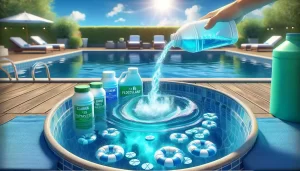Swimming pool maintenance is crucial for maintaining clear and transparent water quality, and one of the issues that has attracted much attention is whether swimming pool disinfectant chlorine tablets and flocculants can be added at the same time. When it comes to pool water cleaning, it’s crucial to understand the interaction between the two and whether they work together. This article will delve into whether swimming pool disinfectant chlorine tablets and flocculants can be used at the same time, and the possible effects of using them simultaneously.
It is best not to use chlorine tablets and flocculants at the same time, although they will not produce significant chemical reactions when mixed directly. However, using the two together may cause the following problems, so it is recommended to allow a certain amount of time between their use.

The difference between two disinfectants
The main ingredients of chlorine tablets
The main disinfectant ingredient of chlorine tablets is chlorinated isocyanuric acid, which releases chlorine in water and has strong sterilization and disinfection effects. Chlorinated isocyanuric acid is widely used in swimming pools and water treatment due to its high effectiveness. To ensure the stability of chlorine during storage and use, preservatives, stabilizers, and other additives are generally added while reducing pungent odors and adverse reactions.
Main components of flocculant
Polyaluminum sulfate is a common flocculant. It has good flocculation properties and can help tiny particles suspended in water to agglomerate into larger clusters for subsequent filtration and removal. Polymeric aluminum silicate is another common flocculant ingredient that forms flocculants in water and promotes the rapid settling of suspended particles.
The main reason why they cannot be used together
- Undissolved disinfectant may be mistaken for flocculated and precipitated impurities. Especially when using chlorine tablets, fine particles will appear due to insufficient dissolution. At this time, these water-insoluble disinfectant particles will be mistaken for floc and sediment, so they will be discharged together or absorbed by the vacuum cleaner, resulting in a decrease in sterilization efficiency.
- Flocculants may affect the uniform distribution of disinfectants If flocculants and disinfectants are used at the same time, the action of the flocculants may cause the formation of dirt clusters in the pool water, which may affect the even distribution of the disinfectant. This can result in some areas being over-disinfected and others not being adequately disinfected.
Correct serving criteria
- Use in stages Before putting in chlorine tablets, use a flocculant to flocculate and settle the dirt in the swimming pool. Then carry out sewage suction treatment to ensure that granular impurities in the pool water are removed.
- Reasonable time interval After the flocculant is used up and removed, there should be a period of time before chlorine tablets can be dropped. This ensures that the flocculant will not be mistaken for insoluble impurities in the disinfectant when used.
- Reasonable use of water circulation and dosing device After using flocculants, ensure proper operation during water circulation and dosing to ensure that flocculated debris is removed and the disinfectant is evenly distributed.
In short, maintaining the water quality of swimming pools is a complex but very important task, in which reasonable operation sequences and time intervals are essential for disinfectant chlorine preparations and flocculants in swimming pools. First, flocculants are used to initially treat particulate matter in the water so that the particles in the water are completely removed. By strictly controlling the mixing and use of various chemical reagents, the effectiveness of water quality maintenance can be ensured to the greatest extent.




